New approach to treating incurable leukaemia in children discovered
Posted: 26 November 2019 | Rachael Harper (Drug Target Review) | No comments yet
A new study into the molecular causes of acute lymphoblastic leukaemia could lead to a new target for therapy.


A team of scientists have been researching the molecular causes of acute lymphoblastic leukaemia (ALL) and may have discovered a new approach to treating the disease.
The study was conducted by scientists at the University of Zurich and the University Children’s Hospital Zurich, both Switzerland, led by Jean-Pierre Bourquin and Beat Bornhauser.
ALL is a form of blood cancer that primarily affects children and young people and involves large quantities of malignant progenitor cells building up in a person’s blood instead of healthy white blood cells. This is often caused by a change in genetic material, with two chromosomes fusing together to create new abnormal genes that disrupt the system controlling normal blood development.
The researchers analysed a protein called TCF3-HLF, which is typically associated with this type of leukaemia and revealed that the abnormal protein TCF3-HLF also activates a range of genes, but it does so in the wrong context and at the wrong point in the blood development process. This triggers the formation of malignant white blood cells and causes leukaemia.
“Our research shows that the abnormal protein binds to almost 500 regulatory elements in the genetic material of the human leukaemia cells, activating hundreds of genes by mistake,” said Yun Huang, lead author of the study.
The researchers also discovered that the abnormal protein gathers more than 100 other proteins around it, which help to activate the genes. “We investigated the function of the individual proteins in this genetic machinery and used this to identify key elements that could be targeted through therapy,” explained Huang.
He and his colleagues used the CRISPR/Cas9 method to detach the specific parts they had identified from the machinery and found 11 critical factors that are crucial to the build-up of malignant abnormal blood cells behind leukaemia.
…the abnormal protein gathers more than 100 other proteins around it, which help to activate the genes”
One of the essential components identified was the protein EP300, a cofactor that boosts gene activation. An experiment with mice indicated that EP300 could be a very promising target for therapy. For this investigation, the researchers used a new kind of substance called A-485, which is known to bind to EP300 and inhibit its activity. When A-485 was administered to mice carrying human leukaemia cells, the malignant cells died off.
“It is therefore possible, in principle, to stop the fundamental driving force behind this leukaemia directly and thus develop a targeted type of therapy,” said Jean-Pierre Bourquin. “The important thing now is to build a fuller picture of what goes wrong so that we can investigate the best possible way to combine specific modes of attack like this.”
Given that other forms of leukaemia are caused by similar mechanisms, it may also be possible to identify a common denominator for developing new drugs to combat cancer.
The study was published in ScienceDirect.
Related topics
Drug Targets, Genetic analysis, Genome editing, Oncology, Protein, Target molecule, Therapeutics
Related conditions
Acute lymphoblastic leukaemia
Related organisations
University Children's Hospital Zurich, Zurich University
Related people
Beat Bornhause, Jean-Pierre Bourquin, Yun Huang


